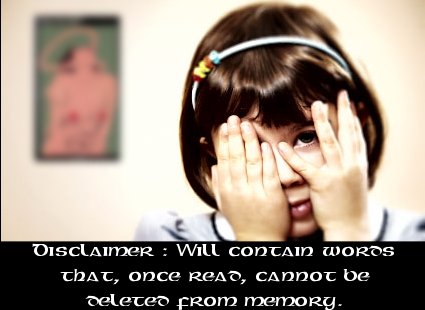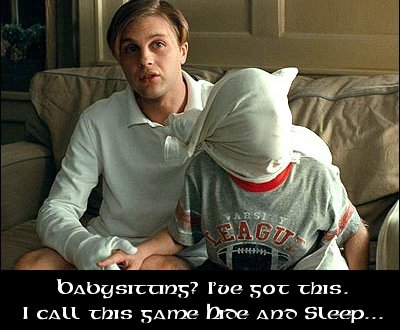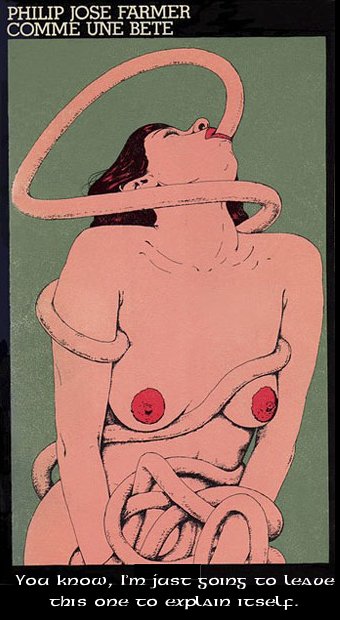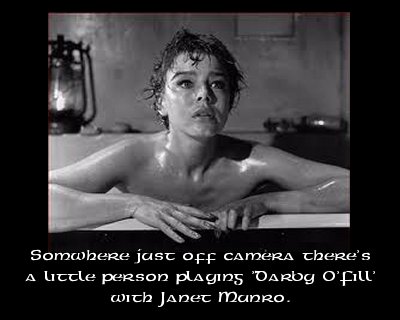
Funny Games with Darby O’Gill; and Images of the Beast:
A Rambling Look at Guilty Pleasures
I’ve often wondered why we call them ‘guilty pleasures’, these little obsessions of ours? Certainly I don’t particularly think that I have anything to feel guilty about in having something of a fixation on old black-and-white horror movies, just for example. However, in the past I’ve dated women who found something just a bit off with it, a grown man and all that.
I gave the whole thing a bit more thought recently after I revisited an old childhood movie, as well as a book from my teenage years; and also watched another movie that I hadn’t seen before. They were, in that order: Darby O’Gill and the Little People; The Image of the Beast; and a vile piece of nastiness entitled Funny Games.
Let’s start with that last one, since this is something that could never, under any circumstances, become a ‘guilty pleasure’ for me. Especially as I’ll never be seeing it again. In fact, I would take the unusual step of not seeing anything by the director Michael Haneke in future. No doubt that will have some people shaking their heads but why would I want to? The little I’ve checked out about this gloomy Austrian just convinces me that even to watch ‘critically acclaimed’ stuff like The Piano Teacher is something that I’m not going to get anything from. I know that the world is rotten; I know that some people are depraved and beyond redemption; I don’t need to spend another interminable two hours watching unmitigated cruelty and sadism directed for no reason at all—in the case of this film—towards an innocent family.
The fact that the cast are superb and the film is well made doesn’t enter into it. (And Naomi Watts is outstanding; Tim Roth is an irritating wimp, but that’s the character he’s playing.) I just for the life of me don’t understand why they would want to be involved in such a tortuous, nihilistic exercise. And this is actually a scene-by-scene remake, by the director, of his Austrian original. Jesus, there’s a sick kind of commitment for you.
I think that the film is repulsive and utterly pointless; but that’s just my opinion. I’m sure that it’s someone’s guilty pleasure. I watch plenty of stuff that others would put in that category and I don’t apologise for it, so I’m hardly in a position to make value judgments. What does irritate me, however, are the Haneke-heads making out that people like me are somehow hypocritical for not recognizing their hero’s genius.
Are they for real? Breaking through the fourth wall is original? Talking to the audience is original? A particularly moronic moment has one of the psychopathic characters get the remote and frigging rewind a scene that the director suspects the audience of approving of! And yes, there’s a place for that but here it just sucks. Even though they bare no similarity apart from accentuating the artificial I couldn’t help but think of Lindsay Anderson’s brilliant If… . Ah, what am I thinking, mentioning one of the best films of the sixties in the same sentence as this dreck? Addressing the audience is original? Before we were ten years old myself and my brother would crack up at those old Bing Crosby/Bob Hope Road to…comedies. Jesus, we would laugh and laugh when they started making asides to us! We couldn’t have put it into words, naturally, but we knew instinctively that the filmmakers were poking fun at the very artifice of filmmaking. A Haneke-head would likely make a thesis out of what a couple of children knew without being told.
Funny Games? Give me a break.

Sure Gob ‘N’ Begorrah! Is that an Erection I’m after Seeing?
The Image of the Beast was a 1968 pornographic science fantasy novel written by Philip Jose Farmer that I stumbled across when I was about fifteen. I was enjoying the Riverworld series at the time and looking for anything else by him. And I found this. I would imagine that my eyes were bursting out of my head like something in a Tex Avery cartoon because even today this one is really out there.
It’s about a private dick called Herald Childe. Yeah, Farmer could be kind of symbolism-heavy and not in a good way; and really, there’s nothing private about Heralde’s dick, boom boom!
He is called in by the Los Angeles police to view a brutally violent snuff movie that features his business partner engaging in some sadomasochism whilst strapped to a table. He’s actually rather enjoying it until a man dressed as Dracula bursts in and bites off the tip of his penis. Yeah, I would imagine that would go beyond the beyond for all but the most hardened—pun intended—S&M buff.
As Childe attempts to track down the killers he comes across a weird band of inter-dimensional sex-crazed vampires and werewolves. Well, it is set in Los Angeles so maybe that’s not as unusual as it sounds. This is where some really great stuff is poured on, even better because he asks the questions we’ve all concerned ourselves with—like where do the clothes and the weight go to when you turn into a wolf and back again? Stuff like that.
I was amused to be reminded that there is an afterword at the back of my beat-up old copy that tries to distance this from pornography. Really? What about this not-untypical scene:
“Her cunt tasted as sweet as Sybil’s, and the hairs seemed to be softer. He put one finger inside her cunt and another finger of the same hand up her anus and then, working the hand slowly in and out, rubbed his tongue back and forth over her clitoris and then tongue-fucked her while his fingers increased the speed of their in-and-out into her cunt and anus.” (Come to think of it, there’s probably an interesting assessment to be done on Farmer as to why he’s so crude about one part of the anatomy and so prim about the other.)
Ah yes, the old argument of what constitutes ‘erotica’ and what, ‘pornography’. I’m open to correction but I think that it might have been Roman Polanski who said: “Erotica is when you are tickled by a chicken feather; pornography is when you get the whole damned chicken.” If that’s the way of it, then I’m going to have to go with Image of the Beast being pornography. It also has one of the weirdest sex scenes that you will ever read, as Childe indulges in a bit of voyeurism that gets him more than he had bargained for, the dirty scut.
Basically, he is spying on a beautiful woman who appears to be masturbating. However, she gradually pulls a long snake-like creature from her vagina. And that’s not all, either. It has a head with a wicked little face complete with a wicked little beard on the end of it. And she takes it in her mouth, only to release it when the head has shot it’s load out of its own mouth. Did you get all that?
Hmmm. I was going to say something smart there about symbolism (apparently the woman is supposed to be Joan of Arc and the serpent-thing is Gilles de Rais) but I’m not clever enough.
This is one of the few books by Farmer that I can still read and enjoy. So, yes: less-than-guilty pleasure.

And finally, a movie offering that went through various stages in my mind over the decades: Robert Stevenson’s film of the Walt Disney 1959 classic, Darby O’Gill and the Little People.
Of course, if you’re a certain age you saw it as a child and loved it unconditionally. Little people, going hunting on tiny little horses and big pots of gold waiting to be tricked out of the leprechauns if you could. What was there not to like?
Then you got a bit older and fancied that you were too sophisticated for top-o’-the-mornin’ blarney like Darby O’Gill or The Quiet Man. But thankfully, if you were fortunate enough and given time, you grew out of being an asshole—or at least into a different kind of asshole—and things came full circle back to where you could really appreciate them for what they were.
What a memorable old rogue Darby (Albert Sharpe) is and what a truly beautiful daughter he has in Katie (Janet Munro). That is obviously what they mean when they talk about ‘sparkling eyes’. Not to mention great lines like: “He was as proud as a whitewashed pig!”
And what about this reverence and fear of the local priest? “A financial venture that you’d be afraid to tell your priest about?” asks the local crow. Of course, the modern audience is thinking to itself: You feckers are the last ones I’d be telling it to.
They live in the little Irish town of Rathcullen where Darby is forever trying to outwit the king of the fairies, Brian, played by Jimmy O’Dea. And even Sean Connery is there, with an Irish accent that is about a billion times better than the one he had in The Untouchables—which of course isn’t saying much since he just merrily goes on with his Scottish one, paying no mind.
The colours! When we were kids, we would come out of the cinema wondering why the colours on the screen were so much brighter than real life. Sometime I still do. And weren’t those special effects pretty damned marvelous for the time?
No, I think that it would be fair to say that Darby O’Gill and the Little People is not a guilty pleasure either—just a pleasure.

Now this utterly self-indulgent article, on the other hand?
Ah, now: that’s a guilty one!

Recent Comments